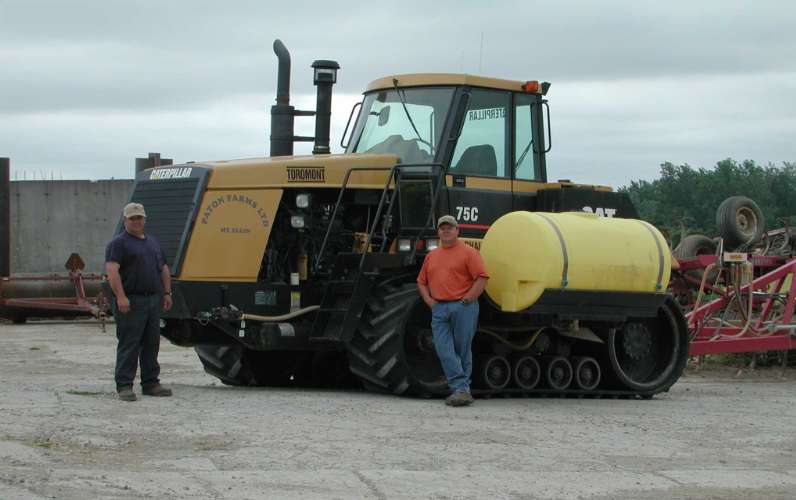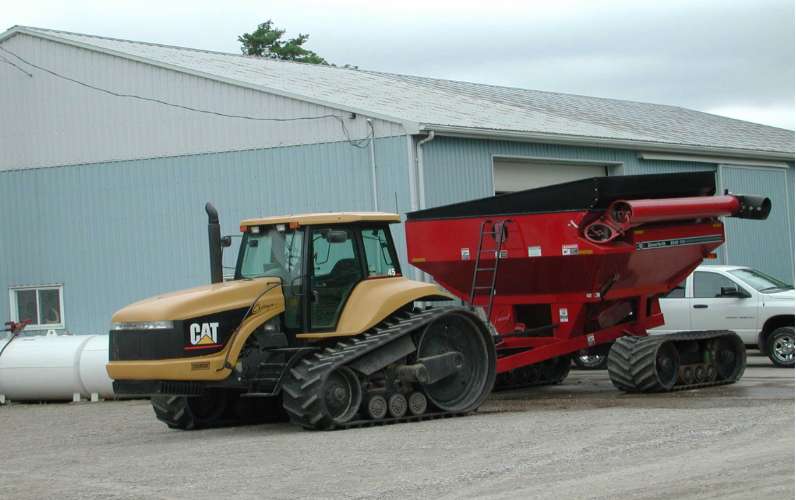
Tracking Down the Solution to Soil Compaction
The best solutions for compaction help to prevent it. Reducing axle loads and tire inflation pressures, and increasing the tire footprint by using larger tires, duals or tracks are all good methods to reduce (but not eliminate) compaction.
Kevin and Duane Paton of Mt. Elgin, Ontario first looked into using tracked tractors in 1988. They farm 1,800 acres of corn, soybeans, wheat and vegetables such as peas, sweet corn and green and lima beans. Since their land covers approximately 7 square miles and soils can vary from black muck to clay, the Patons looked for a minimum 325-hp machine that would provide the needed traction. They found that the Caterpillar 75 C satisfied their standards and in1995 bought their first one. Their 2nd and 3rd tracked tractors were purchased in 1997 and 2000, respectively. Then in 2001, the Patons worked with RWF Bron in Woodstock to design and build a grain buggy with tracks.
Kevin and Duane are very satisfied with the improved traction and reduced compaction their tracked vehicles provide. Reduced slippage improves fuel efficiency and saves time.
 |
Duane estimates that they saved 50 hours of running time the first season they used tracks. Since their tracks only apply 5 psi to the soil, Kevin says “tracks allow us to cheat”, i.e. they can travel across fields (without leaving ruts) that their tired-tractor neighbours perhaps could not. This allows a little more comfort when working in the small windows of operation for the vegetable crops and also a greater opportunity to choose corn hybrids with maximum CHU’s for their area. A tracked vehicle certainly handles differently from a tired tractor, but Kevin and Duane have no problems turning during planting. | |
Kevin and Duane Paton of Mt. Elgin credit tracks for both traction improvement and compaction reduction. |
||
| They can plant directly into the tracks and have seen no differences in corn emergence or growth. The Patons manage their cropping system to reduce compaction where possible. They use a 90-foot boom to limit the number of footprints from spraying. The combine is outfitted with flotation tires inflated to 25 psi and is unloaded in the field into the tracked grain buggy. Kevin has used a hydraulic soil probe to measure compaction in the variable spots in his fields and notes that over time, those areas have become more even. |  |
|
Putting tracks to work on both tractor and grain buggy. |
They use a deep ripper after wheat and soybeans to further reduce compaction. The Patons know that their system can’t eliminate compaction, but they hope the compaction is shallower and more easily removed than with tires.
Duane admits that it’s tough to put a dollar figure on the value of different agricultural equipment. While research in Western Canada comparing tires vs. tracks has shown a 14 to 20 % increase in yield for a track vs tire system (Olds College 2002 1), the Patons have seen a 1 – 2 % increase for their system. They admit that tracked vehicles are premium-priced, but note that it is probably fair, both in price and compaction or traction characteristics, to compare them to tractors equipped with triples. Part of the cost of building their tracked buggy was offset with the use of a used set of tracks. Kevin feels that they see less wear on cultivator teeth and seed disc openers due to reduced compaction. Also, the Patons find less maintenance is needed with tracks vs. tires. They need to check oil levels once a year and the track tension once every 4 or 5, but they don’t need to check ballasting or inflation pressures every time they change equipment, like tired tractor operators should! Of course, narrow road widths are less of an obstacle for their tracked tractors, compared to tractors with duals or triples. Finally, as one landowner from their custom operation business told the Patons, “I like to watch you guys work my land… you’re using the latest technology and not damaging the soil”! How do you put a dollar figure on a happy customer?
1 Olds College Centre for Innovation. 2002. Soil Compaction Yield Effects of Wheeled Equipment Versus Tracked Equipment in a Western Canada Setting – Year 2.
|
Tires vs. Tracks – which system is the best for compaction reduction? The answer to that question may depend who you ask. University of Minnesota extension reports state that properly inflated radial tires or tracks leave similar compaction in the topsoil. Gerry Rock, a salesperson from Firestone Farm Tires says that properly inflated radial tires (especially set up in duals) are better for reducing compaction than tracks. New Holland’s website also asserts that properly inflated radials work best, while John Deere sales information points out that tire and track design has improved over the last several years such that the competitive differences between the two systems are now much less. Finning (which now manufactures the Caterpillar tracked tractors) notes that with 5 – 6 axles, vs. 2 on tire tractors, tracked vehicles offer fewer pounds per axle for a given tractor weight, as well as a bigger footprint which both help reduce compaction. The contention seems to be: which system puts the least pressure on the ground? A tractor that leaves a large footprint, such as from tracks or duals, will spread the axle weight over greater area, thus reducing the average ground pressure. Research done in Auburn, Alabama 1 however found that average ground pressure does not represent actual pressures under tracks. They reported significantly more pressure under the center lugs and rollers of the tracks than the rest of the belt, while radial tires on a tractor of the same weight distributed that weight more uniformly over the footprint. Overall, they reported lower pressures from properly inflated radial tires than from rubber belt tracks. Other researchers at Ohio State 2 examined soil compaction, as measured by total soil porosity, under a 350 HP tracked tractor compared to a 310 HP tractor outfitted tires where inflation pressure was varied. Their results showed soil compaction ranked in this order, from highest to lowest: high pressure tires > tracks > low pressure tires. 1 Turner, Reed and Randy L. Raper. Soil Stress Residuals as Indicators of Soil Compaction. Presented at the 2001 ASAE Annual International Meeting. Sacramento, California. July 29 – August 2, 2001. Paper No. 011063. 2 Hoeft, R.G., Nafziger, E.D., Johnson, R.R. and S.R. Aldrich. 2000. Modern Corn and Soybean Production. First Edition. MCSP Publications, Champaign, IL. p.79. |